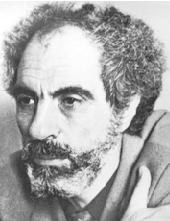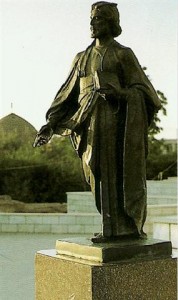Wed 19/Nov/2008 - 29/Aban/1387
The Politicization of Nizami Ganjavi
In recent years, there have been active efforts at re-defining Iranian cultural and historical icons as non-Iranian mainly to fit into the ideological parameters of recent nation-building efforts.
One such figure to fall prey to politicization and nation building is the Iranian great and famous poet Nizami Ganjavi. This was initiated during the tenure of Soviet leader Joseph Stalin (1878-1953). This was part of the overall process of nation-building in which Soviet ethnic engineers began to lump all historical figures and references from Albania/Arran (renamed Republic of Azarbaijan in 1918) and the historical Azarbaijan in Iran as Azerbaijanis, pretending that these were never distinct provinces of Iran, and that neither had any cultural, linguistic or historical association with Iran.
Stalin specifically worked at removing pre-communist (Tsarist) archives that referred to the historical designations of the Republic of Azarbaijan. This included the Russian language 'Russian Encyclopedia' (printed in 1890, St. Petersburg & Leipzig, Imperial Germany (Matini, 1989, p.455) which clearly distinguished Albania/Arran from Azerbaijan in Iran.
Stalin deliberately and repeatedly referred to many famous Iranian literary figures (such as Nizami Ganjavi as 'great national Azarbaijani literary figures', with no mention of their association and origins in Persia. Stalin is on record for having stated with respect to Nizami Ganjavi that:
... [Nizami] must not be surrendered to Iranian literature, despite having written most of his poems in Persian. (Kolarz, 1952).
However, Nizami Ganjavi wrote all of his works in Persian and he doesn't have any non-Persian writing at all! The statement was clearly aimed at rewriting history in the name of Soviet ethnic engineering. It was meant to convey the impression that (a) Nizami Ganjavi was Turkic in origin and (b) wrote his 'other' poems in Turkish. Russian historians however have acknowledged that Nizami Ganjavi was:
one of the famous Persian poets ... wrote exclusively in Persian.... (From the Brockhaus and Efrona Encyclopedia, as cited by HOEB article of Moscow, Russia).
Historical documents were deliberately falsified by the Soviets (Tiwali, 1984) to portray Nizami as being of “Caucasian nationality” and that his original poetry was composed in Turkish and followed later by “Farsi [Persian] translation“.
Few are aware that long before Soviet Russia, Czarist Russia promoted pan-Turkism to destroy the Persian literary, cultural and historical legacy in the Caucasus. As you may know, Iran was forced to cede her possessions in the Caucasus (everything above the Araxes River just above Azarbaijan) to Russia. Hostler noted that the Russians, despite their victory in the Caucasus, were very concerned with the power, depth and hold of the Persian language and culture of Iran over Arran (present-day Republic of Azerbaijan):
This cultural link between the newly conquered country [modern-day Republic of Azerbaijan, historically known as Arran until May 1918] and its still strong Persian neighbor annoyed Russia who tried to destroy it by supporting local Turkish cultural developments” (Hostler, 1957, p.22).
Indeed, the local authorities in the khanates were either Persian-speaking or of aristocracies who spoke Persian. The Shiite clergy who held considerable influence over the local courts and schools, helped maintain the influence of Iranian culture in the Caucasus. Professor Swietochowski notes that:
“The hold of Persian as the chief literary language in [the current Republic of ] Azerbaijan was broken, followed by the rejection of classical Azerbaijani, an artificial, heavily Iranized idiom that had long been in use along with Persian, though in a secondary position. This process of cultural change was initially supported by the Tsarist authorities, who were anxious to neutralize the still-widespread Azerbaijani identification with Persia.” (Swietochowski, 1995, p.29).
This policy was consistent with Czarist policies with respect to other recently conquered non-Russian nationalities of the empire (1995, p.29). However it is important to realize that de-Iranianization by Russia goes further back prior to the Soviet era. As noted previously, the greatest fraud was in re-naming the former Iranian province of Arran in the Transcaucasus as “Azerbaijan” when in fact no such appellation existed prior to 1918. The “name-change” occurred only when the pan-Turkist Musavat regime named it as much in late May of that year. Many of the members of Musavat government were former pan-Turk Ottoman officers who had supported the Musavat takeover of Baku in 1918:
Professor Nazrin Mehdiyova, herself a historian from the modern Republic of Azerbaijan has noted that:
... the myth [of a North versus South Azerbaijan] was invented under the Soviets for the purpose of breaking Azerbaijan’s historical links with Iran. To make this historical revisionism more acceptable, the Soviet authorities falsified documents and re-wrote history books. As a result, the myth became deeply ingrained in the population [modern-day Republic of Azerbaijan, historically known as Arran until May 1918] and was adopted by the PFA [Popular Front of Azerbaijan] as part of the rhetoric. (Mehdiyova, 2003, p.280).
It is a tragedy to see so many of the citizens of the Republic of Azarbaijan today who are acutely unaware of their proud Iranian legacy, these being victims of close to 2 centuries of Russian and pan-Turkist political and ideological manipulation.
Interestingly, many of the educated Arranis fully acknowledge that their region was known as Arran. They also acknowledge their strong bonds to Iran. Unfortunately however, the first president of the Republic of Azarbaijan, Abulfazl Elchibey (1938-2000), was extremely anti-Iranian and a fanatic pan-Turkist:

Abul-Fazl Elchibey
Showing a total lack of diplomatic protocol, Elchibey declared in a state visit to Turkey that he viewed Iran as a “doomed state“. His dislike of Iran was to continue to his final years, as indicated by his writings calling for the partition of Iran.
Elchibey’s ideology did much harm to the newly founded republic; it led to the loss of much territory to the Armenians and he certainly failed to win friends in Iran. This is indeed tragic as Elchibey was often described as a pious and humble man. The tragedy with Elchibey is that he is one of the many people of the former Soviet Union who has been manipulated by Russian (Czarist and Soviet) ethno-engineering methods, not to mention pan-Turkism.
For further reading on the subject I recommend consulting the following excellent article:
Doostzadeh, Ali. Politicization of the background of Nizami Ganjavi: Attempted de-Iranization of a historical Iranian figure by the USSR, June 2008.
URL: http://sites.google.com/site/rakhshesh/articles-related-to-iranian-history
Also Dr. Dariush Rajabian has an excellent article in three parts on de-Persianization of the Caucasus, Central Asia and Afghanistan: The Axed Persian Identity
Part I
Part II
Part III
[the complete Persian translation by Shahrbaraz of this second article is available on Azargoshnasp. ]

The statue of Nizami Ganjavi in Tabriz, Iran
Further readings:
Hostler, C.W. (1957). Turkism and the Soviets. London: George Allen Unwin Ltd.
Kolarz., W. (1952). Russia and her Colonies. London: George Philip.
Matini, Jalal. (1989). Azerbaijan Koja Ast? [Where is Azarbaijan?]. Iranshenasi: A Journal of Iranian Studies, I (3), p.443-462.
Swietochowski, T. (1995). Russia and Azerbaijan: A Borderland in Transition. New York: Columbia University Press.
(taken from the website of Dr. Kaveh Farrokh with some minor modifications).


1 نظر:
سپاس فراوان
مقاله ها محشر بودند
واقعا" مغزم سوت کشید
Post a Comment